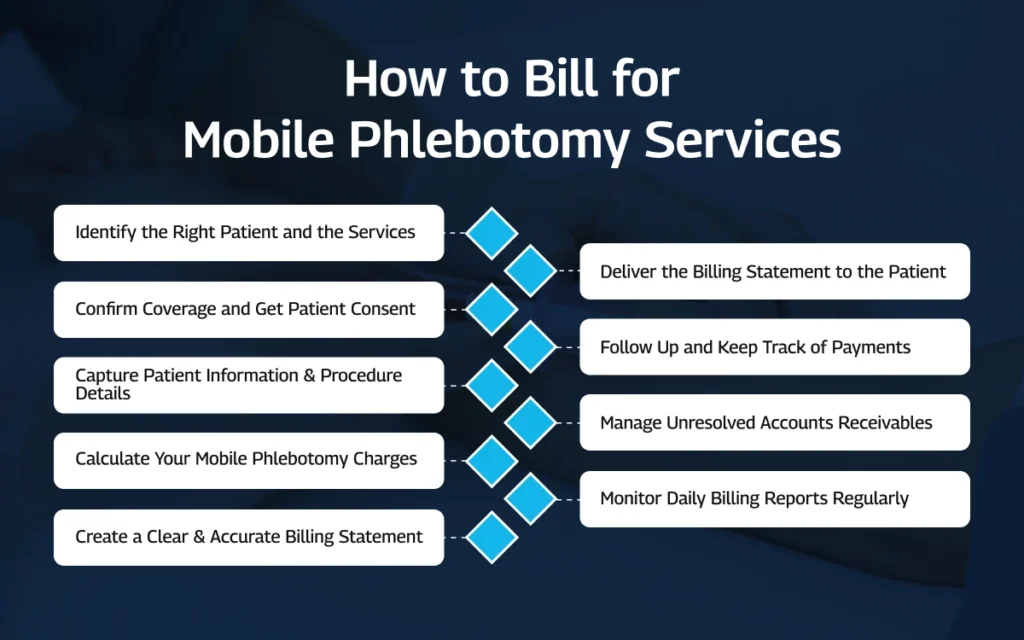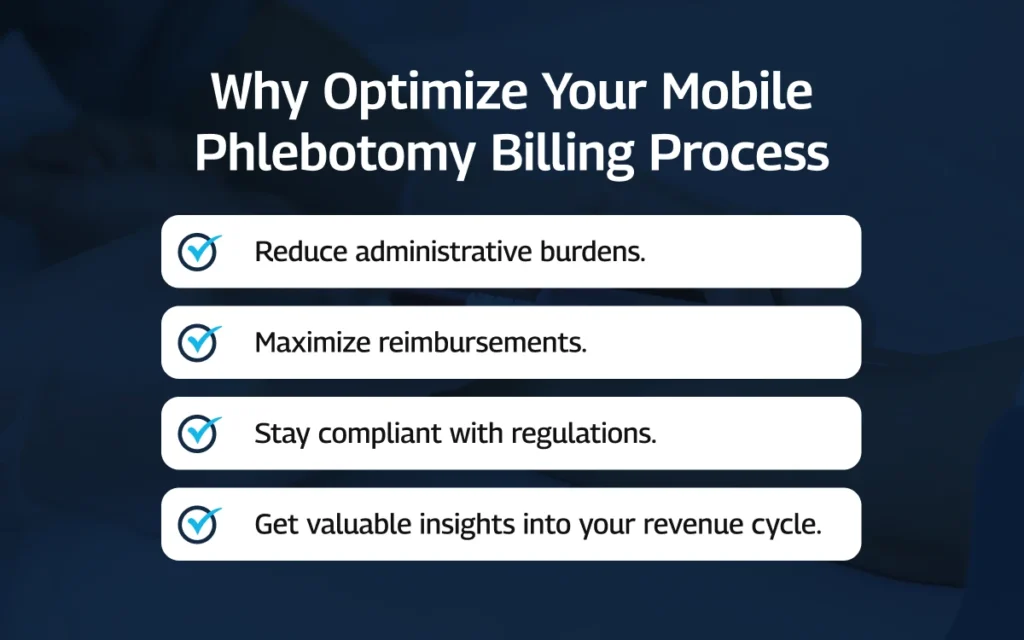Mobile phlebotomy services offer a convenient and efficient way to collect blood samples for medical testing. However, ensuring proper billing and reimbursement for these services can take time and effort. We’ll break down the mobile phlebotomy billing process into easy-to-understand steps.
How to Handle and Bill for Mobile Phlebotomy Services
From documenting patient information and procedures to generating clear billing statements, this comprehensive guide will help you streamline your mobile phlebotomy billing and revenue cycle and ensure timely payments.

1. Identify the Right Patient and the Services
The mobile phlebotomy billing process will be streamlined only if you ensure the accuracy of the right patient data and verify that the correct phlebotomy services, also known as the blood draw or venipuncture, are requested.
Why do this?
Well, double-checking patient details prevents mix-ups. We want to guarantee that the drawn blood or sample belongs to the intended patient, avoiding potential errors.
Verifying the requested service is equally important. Whether it’s a blood draw, a urine sample, or a specific test like allergy testing, collecting the right sample ensures it serves the right purpose.
Gather the Right Information
- Patient’s Full Name
- Patient Identification Number
- Requested Services
- Requesting Party (doctor, clinic, lab)
If details are incomplete, contact the requesting Party for clarification before proceeding. Double-check information and address any inconsistencies to ensure accuracy in your billing process.
2. Confirm Coverage for Mobile Phlebotomy
Verifying patient’s insurance coverage before proceeding with mobile phlebotomy services is essential. It allows you to bill the correct Party (insurance company or patient) and append the appropriate billing codes for covered services. It also helps avoid unexpected costs for the patient and potential delays in collecting payment.
Gather These Insurance Details
- Patient’s Insurance Company
- Insurance Policy Number
- Policy Expiration Date
Let us share challenges while confirming the coverage for mobile phlebotomy services.
If the patient doesn’t have their insurance card readily available, you can jump on online insurance portals or quickly call the provider. Also, inform the patient about an expired policy that helps them contact their insurer for renewal before the service.
3. Get Patient Consent for Mobile Phlebotomy
Getting informed consent from the patient is important before proceeding with the phlebotomy services. It helps patients understand the phlebotomy procedure, potential risks, and alternative options before giving their permission. And it shows adherence to legal and ethical guidelines.
To ensure a smooth consent process, you must use a standardized consent form that typically outlines:
- A clear explanation of the phlebotomy process.
- Potential risks or discomforts associated with the procedure.
- Alternative options are available if applicable.
Provide clear and concise explanations, answer questions patiently, and use simple language the patient can understand. Encourage them to ask questions until they feel fully informed. Respect the patient’s decision and avoid pressuring them.
4. Perform the Mobile Phlebotomy Procedure
A qualified phlebotomist follows established protocols to collect the necessary blood samples efficiently, safely, and with patient comfort in mind. The reliable results ensure quality care and a seamless billing process for the procedure.
5. Ensure Sample Integrity
After a successful blood draw or venipuncture, healthcare providers must ensure the collected samples reach the lab in pristine condition. It guarantees accurate test results and creates a positive experience for the patient.
Here’s how you do it:
- Label each sample container with essential patient information, such as name, identification number, and collection date.
- Store samples at the recommended temperature to avoid deterioration.
- Transport to the designated lab on time to minimize any delays in analysis.
- Ensure the phlebotomist wears appropriate personal protective equipment (PPE).
- Adhere to infection control protocols to minimize the risk of infection.
6. Capture Patient Information and Procedure Details
Start proper documentation after performing a successful mobile phlebotomy procedure. Detailed records ensure accurate billing for the services performed, streamlining the process for the provider, the patient, and the insurer. Comprehensive documentation clearly shows the patient’s medical history and past procedures.
Capture this information for detailed documentation:
- Patient demographics, including the patient’s full name, date of birth, and identification number.
- Procedure details, including the date of the phlebotomy procedure, the type of sample collected (blood draw, urine sample, etc.), and any relevant information about the procedure are recorded.
To address potential challenges, standardized forms are used to ensure all necessary fields are captured. If the information seems incomplete, politely ask clarifying questions from the patient or requesting Party. And encourage legible handwriting when documenting. Consider using electronic documentation systems to minimize errors.
7. Calculate Your Mobile Phlebotomy Charges
This step of the mobile phlebotomy process involves calculating the total charge for the services rendered, ensuring fair compensation and accurate billing for the provider, the patient, and the insurance company.
Get the cost breakdown from the pricing and fee schedule.
- Base Service Charge
- Additional Fees
- Discounts and Promotions
- Insurance Coverage
- Volume Discounts (If applicable)
Note: Don’t hesitate to consult the billing department for clarification. Double-check your calculations because even minor calculation errors can lead to billing issues. Connect with us right now for a free consultation.
8 Create a Clear and Accurate Billing Statement
After calculating the final charges, it’s time to generate the initial billing statement for the mobile phlebotomy procedure. A clear and well-organized billing statement fosters trust between the patient and the insurance company.
Here’s what a mobile phlebotomy billing statement should include:
- Patient Information
- Service Details
- Itemized Charges
- Total Charges
- Billing Date
- Payment Terms
Use reliable billing software or established templates to minimize the risk of errors during statement generation. Double-check all entered data for increased accuracy.
9. Deliver the Billing Statement to the Patient (After Approval)
Once the precise and accurate billing statement is finalized, it’s time to get it into the patient’s hands. Timely delivery of the billing statement ensures the patient has the information they need to review charges and make a payment.
Here’s how to ensure accurate delivery to avoid payment delays and disputes:
- Double-check the patient’s contact details.
- Use reliable methods like certified mail or secure electronic delivery.
- Send the statement electronically or access it through a patient portal.
Suppose the patient’s insurance is expected to cover the mobile phlebotomy service. In that case, the statement might need to be pre-approved by the insurance company to determine coverage and potential patient responsibility.
10. Follow Up and Keep Track of Payments
Once the billing statement is delivered, following up on outstanding payments or unpaid invoices is essential.
Here’s how to ensure everything goes smoothly:
- Offer clear payment instructions.
- Send gentle payment reminders after the due date.
- Work with patients to explore flexible payment options.
After delivering the billing statement, monitor payments and address any outstanding balances. An efficient system for tracking payments helps mobile phlebotomy providers maintain a healthy cash flow.
11. Record and Reconcile Payments
Once payments arrive, it’s time to process and record them accurately. Efficient processing of received payments ensures proper reimbursement and avoids accounting errors. Here’s how to ensure smooth processing:
- Record and manage incoming payments.
- Maintain clear documentation of all transactions.
- Cross-reference payment details (amount, patient name) with the corresponding billing statements to ensure accurate allocation.
These steps will ensure smooth billing for mobile phlebotomy services and maintain a clear picture of their revenue cycle.
12. Maintain Accurate Records
Once payments are processed, remember to update patient billing records. Detailed records clearly show a patient’s account history, including services rendered, payments received, and any outstanding balances.
These patient records also serve as a valuable resource for future billing needs or potential inquiries from patients or insurance companies. Accurate records streamline future billing processes and minimize the risk of errors.
Here are some ways to ensure accurate patient billing records:
- Update patient accounts upon receiving payments.
- Document any adjustments made to the original bill.
- Archive past billing records for easy retrieval if needed.
13. Work With Insurance
A patient’s insurance plan might cover mobile phlebotomy services. Mobile phlebotomy services require pre-authorization or specific billing codes depending on the insurance plan.
Here’s how to navigate insurance:
- Verify the patient’s insurance coverage details before performing the service.
- Use the correct medical billing codes when submitting claims.
- Maintain clear communication with the insurance provider.
14. Manage Unresolved Accounts
Not all billing issues can be resolved immediately. The patient account might still need help with your efforts to collect payment.
Here’s how to approach unresolved accounts:
- Communicate with the patient even further to understand the reason for non-payment.
- Conduct an internal review of the account to ensure all billing and collection procedures are followed correctly.
- Go for collection agencies to recover the outstanding balance as a last resort.
Important Note: Before involving a collection agency, adhere to all relevant regulations and guidelines regarding patient communication and debt collection practices. You can also consult with LBS for free before taking such steps.
15. Monitor Daily Billing Reports
Effective billing goes beyond processing individual transactions. Regularly reviewing billing reports allows mobile phlebotomy providers to gain valuable insights into their financial health.
We at LBS follow this report monitoring process:
- Generate a comprehensive daily billing report with billing software.
- Review the report regularly to identify trends and areas for improvement.
- Archive completed billing reports for future reference and potential audits.
Establishing a routine for generating and reviewing daily billing reports offers valuable insights that empower them to make informed business decisions and achieve long-term financial stability.
Optimize Your Mobile Phlebotomy Billing Process
Managing mobile phlebotomy billing in-house requires dedication and expertise. However, partnering with a reliable medical billing service like LBS can free up valuable time and resources for your practice.
We offer a comprehensive suite of lab-specific billing services tailored to the unique needs of mobile phlebotomy providers. Our certified coders and billers understand the complexities of medical coding, insurance regulations, and revenue cycle management.

- Reduce administrative burdens.
- Maximize reimbursements for your mobile phlebotomy services.
- Stay compliant with regulations
- Get valuable insights into your revenue cycle.
Contact us for a free consultation about how we can streamline your mobile phlebotomy billing and help your practice or lab thrive.
